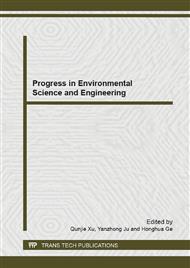p.1315
p.1321
p.1328
p.1333
p.1338
p.1343
p.1349
p.1354
p.1359
Optimization for Water Outlet of an Ozone Contactor by Computational Fluid Dynamics
Abstract:
Geometry optimization is an effective method to improve the hydraulic efficiency of an ozone contactor. The enhancement of hydraulic efficiency can lead to a smaller dose of ozone and thus minimizing the potential risk caused by disinfection by-products. Unlike adding some extra structures in geometries in previous studies, optimization for water outlet was applied to improve the hydraulic efficiency in this paper. The water outlet was modified to several parallel flumes arranged uniformly on the top of the contactor from overflow weir. In a typical contactor with diffusers, the effect of water outlet optimization on system performance was studied based on computational fluid dynamics employing a two dimensional Euler model coupled with species transport model and discrete particle model. The T10/HRT, the most common indicator of hydraulic efficiency, was improved by 10%-24% with less short-circuiting after optimization. Compared to the original geometry, optimization for water outlet brought about a 19.6% increase in log inactivation, which represents the disinfection efficiency. To maintain the same Cryptosporidium inactivation efficiency after the water outlet optimization, ozone dosage could be reduced by 18% from 2.0 mg/L to 1.64mg/L, which resulted in a minimization of bromate formation by 8.90%.
Info:
Periodical:
Pages:
1338-1342
Citation:
Online since:
December 2012
Authors:
Price:
Сopyright:
© 2013 Trans Tech Publications Ltd. All Rights Reserved
Share:
Citation:


